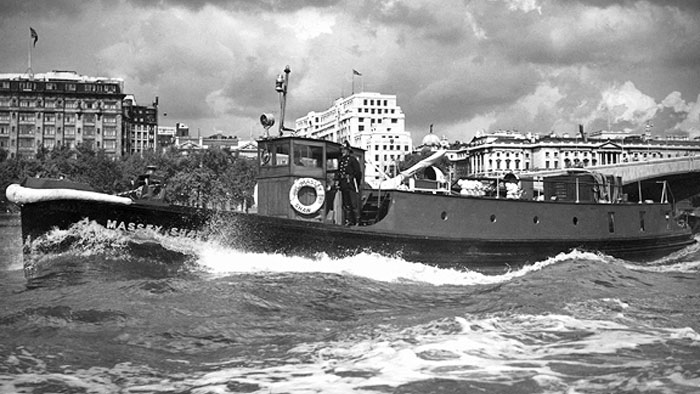The Massey Shaw was built by J Samuel Whites of Cowes, Isle of Wight in 1935 to a design of the London County Council, who wished her to be able to go under all the bridges on the Thames, its tributaries and at any state of the tide. The vessel cost £18,000 to complete and had an impressive specification. She was named after the first Superintendent of the Metropolitan Fire Brigade Captain Eyre Massey Shaw.
The early years
Massey Shaw was based at Blackfriars Pier and was heralded as a great addition to the fire fighting capabilities of the London Fire Brigade River Service, and soon proved her worth.
Within a few months the Massey Shaw demonstrated her full capabilities whilst fighting a large warehouse fire at Colonial Wharf, Wapping. The fire had gained hold of an eight storey warehouse complex and the fire fighting operations were hampered by difficult access. Massey was able to supply a vast jet of water that made a firebreak and allowed the land based crews to regroup and stop the fire spreading. Newspapers at the time credited the Massey Shaw with saving over a million pounds worth of stock.
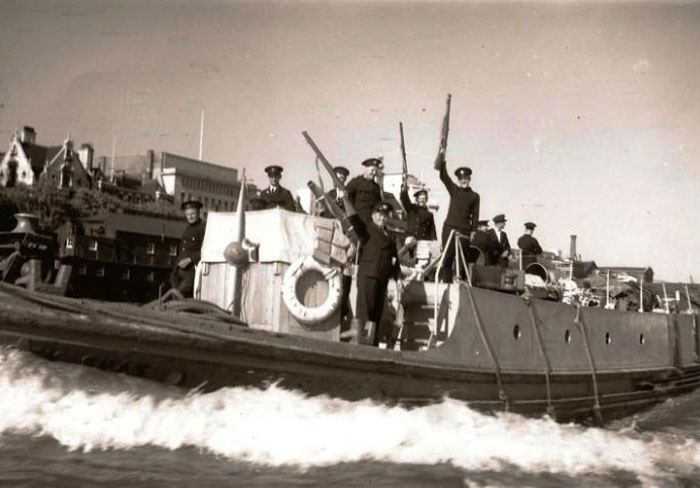
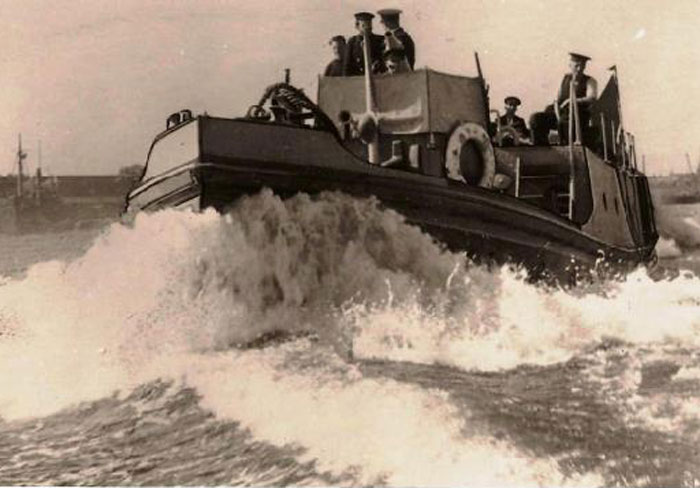
Dunkirk and the war years
Massey Shaw’s finest hour came in May 1940 when she answered a call from the Home Office asking her to take part in Operation Dynamo. Massey Shaw made three trips with her volunteer crew of LFB, AFS and NFS Firemen, rescuing some 500 troops from the beaches and bringing back a further 110 to Ramsgate. In addition to this noble work, on her return to London the Massey rescued thirty French merchant seamen when their vessel, the “Emil de Champ”, hit a mine.
On her return to her home port, the Massey Shaw was heavily involved in fire fighting operations during the Blitz as the Germans dropped an increasing number of high-explosive and incendiary bombs on the riverside warehouses. The Massey Shaw and her sister ships were involved in supplying water to the hundreds of land based pumps fighting the major fires up and down both sides of the Thames.
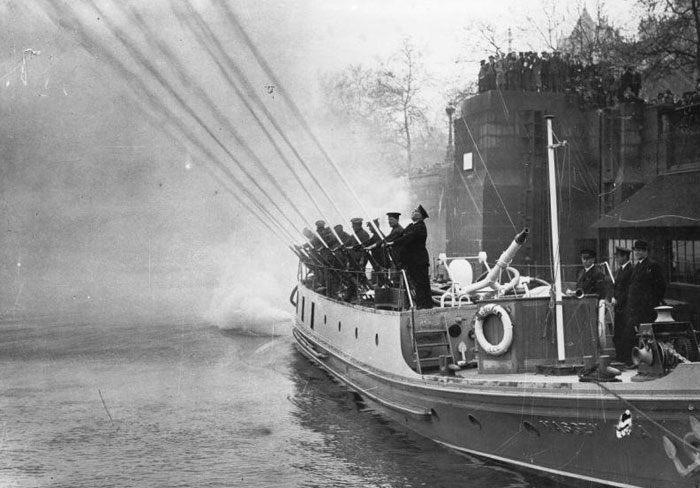
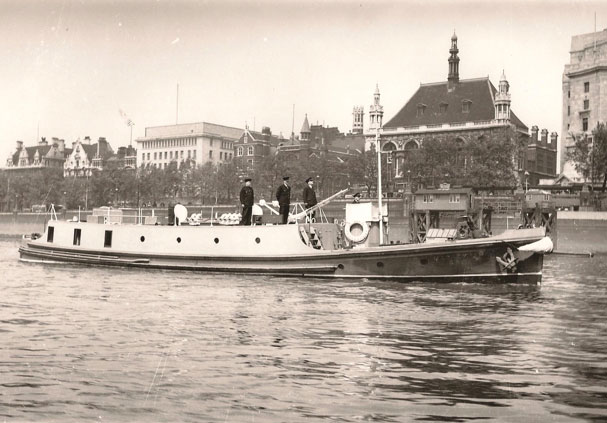
The later years
The Massey Shaw continued as an operational fireboat on the Thames until 1971, when she was decommissioned by the London Fire Brigade. During this time she tackled many riverside blazes including a margarine factory in Wandsworth during the 1950s.
After this, Massey Shaw was moved to different locations on the Thames whilst the Fire Authority decided what should be done with her. Fortunately in the early 1980s the Massey Shaw was moved to St Katherine’s Dock, by Tower Bridge, where she was seen by several enthusiasts including Philip Wray and Dick Helyer. At this time Massey Shaw was looking in a sorry state; she was being used as a walkway for people to get to other craft, and her general condition was poor.
Undeterred by her dilapidated condition, Philip Wray gathered a group of people to form charitable preservation society to restore this historic craft to her former glory. Many battles were fought along the way with the Fire Authority and various other organisations who had their doubts about handing over the Massey Shaw to this unknown group. Finally, “The Massey Shaw Fireboat Society” were given a fifty-year lease on the vessel from the Fire Authority, and work began in restoring the craft back to working condition.
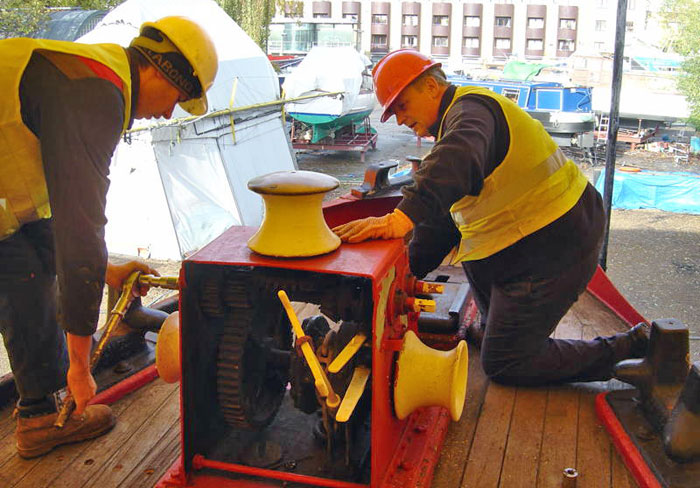
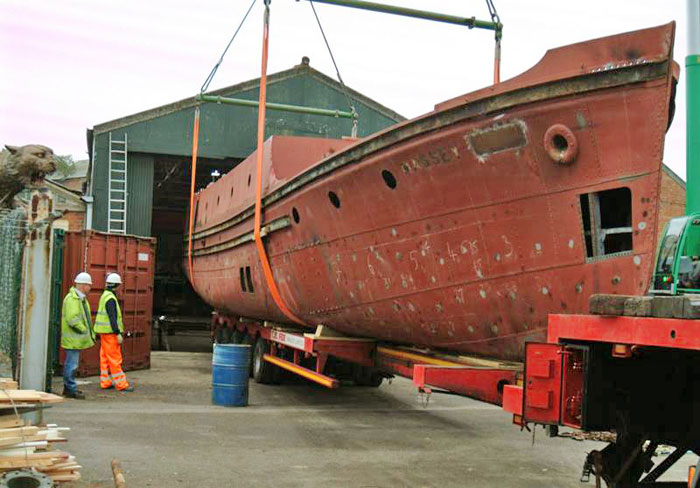
Restoring Massey Shaw
We collected Massey Shaw from South Dock in London and transported her to Gloucester along with a lorry load of assorted fittings. She had been virtually stripped out forward and aft with the engine room intact minus the starboard engine.
Although the hull was badly corroded on the wind and waterline, the rest of the hull was in reasonable condition due to the fact that the hull plates, frames and deck beams were all galvanized prior to riveting when she was built in 1935. Therefore, apart from a few localized repairs and a number of wasted rivets, the main steelwork requirement was for a 16” strip around the waterline. It was decided rather than wholesale plate replacement, we would ‘cut back to good steel’ and insert new. This was welded to the existing plates and then riveted to the frames and laps with half inch rivets, as per the original.
The other major steelwork job was the dismantling and reconstruction of the fire pump suction boxes; these were riveted in situ which is no mean feat as they had to be riveted inside the confines of the suction boxes. Once the riveting was complete all the new laps and any other joints where the rivets had been replaced had to be caulked – a process even louder than the riveting! In total we replaced 3,500 rivets and 24 square metres of shell plate.
The original teak deck was 2” thick and had worn in some places to less than half this thickness. This was removed and the complete deck replaced with new teak. The original butt plan was adhered to as there were butt plates riveted to the deck beams. The deck was then caulked traditionally with oakum and pitch.
Next came the hard bit – putting it all back together.
The Port engine was extracted from the ship and sent to Gardner Marine Diesels in Canterbury to join the Starboard engine. The Starboard engine had to be completely built up from scratch, and when complete, both engines were run on the test bed to check their performance. In the meantime all the pumping pipework and the main Merryweather fire pumps where dismantled, cleaned and serviced. The deck manifolds for the fire hoses, the monitor and the suction manifold, all had to be overhauled and rebuilt using new leather lip seals (still available) as original in 1935.
New shafts, bearings and propellers from Clements Marine were fitted and the Russell Newbury air compressor and generator were refurbished, along with all the air start pipe work and cylinders. The rudder and bearings, the top one being Lignum Vitae, and the steering gear were dismantled, overhauled and the wires replaced.
The existing wheel house was refurbished and refitted along with the original wheel and brass telegraphs. The helmsman has two telegraphs – one is for the normal engine commands and the other is in “Pounds per Square inch” instructing the two engineers to maintain the requested pump pressure for the fire pumps.
We reclaimed the original deck planks to use as the new sole in the accommodation. We also managed to source some reclaimed black and white floor tiles for the galley to match the original floor in the heads. A complete new electrical system was fitted hidden inside period electrical cabinets with the wiring, in ships wiring cable, clipped with brass onto the original cable trays.
Throughout the restoration we tried to use as much of the original boat as possible, even down to the old battered doors in the accommodation, which give it character, So essentially Massey Shaw is the same vessel that was launched in 1935 – with a few mod cons to bring her up to date.
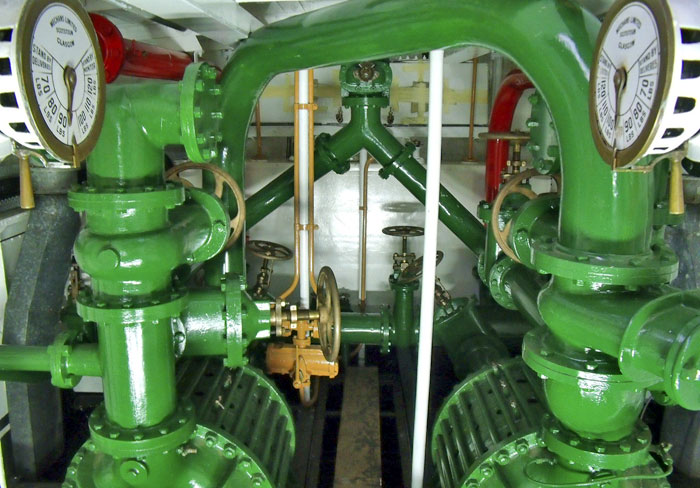
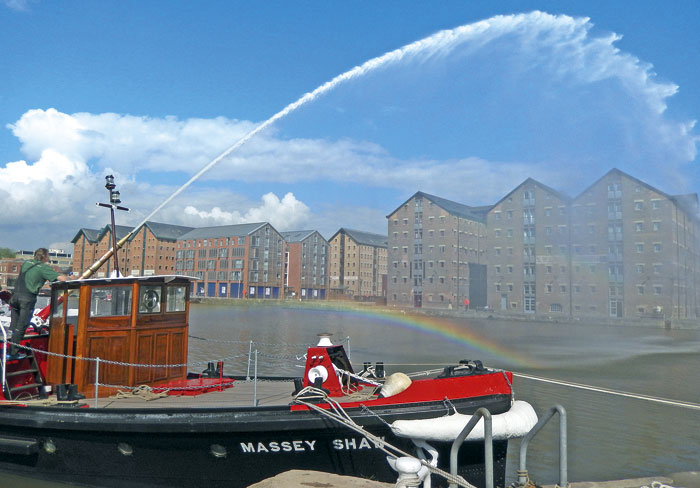
Built: J. Samuel Whites of Cowes, Isle of Wight in 1935 to a design of the London County Council
Rebuilt: T. Nielsen & Company, Gloucester, 2013
Owners: The Massey Shaw Education Trust Limited
Length: 78 feet (23.8m) | Beam: 13 feet 9 inches (4.2m) | Draught: 3 feet 9 inches (1.1m) | Gross tonnage: 50.54 tons (51.35 tonnes)
Engines: Twin 8-cylinder Gleniffer DH8 Diesels each producing 165 Bhp (123kw)
Speed: 12 knots (22kph)
Pumps: Twin Merryweather 4-stage 8 inch centrifugals each producing 1,500 gpm (6,819 litres per minute)
Auxillary Power: Russel Newbery & Co. Ltd 2-cylinder Diesel type D2 producing 18Bhp (13.4kw) at 1,000 rpm

